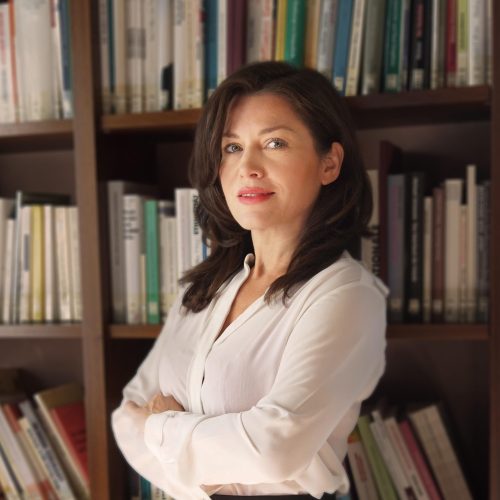Hanni Geiger

Research
Hanni Geiger is an art historian and passionate about the art and design of the 20th and 21st centuries, especially the interrelations between exile, migration and artistic production; postcolonial, global and transcultural art and design; the representations of the body and technology in art and design; as well as digital art history and posthumanism.
At global dis:connect, Hanni rethinks vacation regions as sites where entanglements and disentanglements intersect from an art historical perspective. She examines art, architecture, design, crafts and environments that reflect Adriatic complexities, referring to visual representations of connections and non-connections between the Adriatic littoral and tourism as a global force. Through visual arts, the project takes a metaphorical detour around the ‘destination Adriatic’ — imagined as a globally interconnected region — towards an Adriatic as a topos of materialised interruptions, absences and frictions. She looks predominantly at non-commercial visual works from the 1950s to the present in relation to commercial pieces of the time that reveal stylistic, ecological, gender related, seasonal and infrastructural dis:connections. By theorising Adriatic complexities as visualised in manifold aesthetic practices, genres and methods, this project fosters alternative ways to approach globalisation from the perspectives of the humanities and the arts while contributing to non-hegemonic art history. The Adriatic is an overlooked branch of the Mediterranean and serves as a laboratory of globalisation, which is a perspective that bypasses national frames and stereotypes, suggesting broader application to the entire Mediterranean and indeed all of Europe.
Hanni obtained her PhD in 2014 with her dissertation on the British-Turkish artist and designer Hussein Chalayan, treating the correlation of migration and artistic production in his work (see selected publications).
Biography
Hanni Geiger is a postdoctoral researcher at the Käte Hamburger Research Centre: global dis:connect. From 2019 until 2021 she was a research associate and a coordinator of the DFG Priority Programme The Digital Image. Prior to that, she was a senior lecturer in the Department of Design at the AMD Akademie Mode & Design/Fresenius University of Applied Sciences, Munich (2016–2018). From 2013 until 2015, Hanni was a research associate at the LMU Institute of Art History, where she obtained her doctorate in 2014. She also served as a junior researcher in the Exil, Migration und Transfer project of the Center for Advanced Studies in Munich (PI: Prof. Dr. Burcu Dogramaci) (2011–2012) and as a project employee at the Goethe-Institut Croatia (2008–2009). Having studied fashion design in Zagreb and art history, art education and intercultural communication at the LMU Munich, Hanni lectures at the Design Academy of the Munich Chamber of Commerce and the Academy of Fine Arts in Munich.
Selected Publications
Click here for Hanni’s CV, including a full list of publications.
Fluidität [Fluidity] (Begriffe des digitalen Bildes [Concepts of digital images]; vol. 4), edited with Julian Stalter. Munich, 2023. https://doi.org/10.5282/ubm/epub.105063.
‘Das fluide Menschenbild. Digitale Ver- und Entkörperungen im Dazwischen’ [The fluid human image. digital (dis/em)bodiments in the in-between]. In Fluidität [Fluidity] (Begriffe des digitalen Bildes [Concepts of digital images]; vol. 4), edited by Hanni Geiger/Julian Stalter, 31–49. Munich, 2023. https://doi.org/10.5282/ubm/epub.105063.
Dis:connected objects. static 2, no. 1 (2023), edited with Burcu Dogramaci/Änne Söll. https://doi.org/10.5282/static/34.
‘Past:present represent. Imaging dis:connected Mediterranean bodies’, static 1, no. 1 (2022): 15–21. https://doi.org/10.5282/static/3.
‘Transkulturalität – Aktuelle Perspektiven in zeitgenössischer Gestaltung und Kunstwissenschaft’ [Transculturality – Current perspectives in contemporary art and design]. In Begegnungen. Kunstpädagogische Perspektiven auf Kunst- und Bildgeschichte [= Kunst Geschichte Unterricht; vol. 2], edited by Johannes Kirschenmann/Frank Schulz, 404–435. Bielefeld, 2021.
‘Beyond humanism. Beyond cultural distinction?’, Exploring visual cultures (2021). https://www.explore-vc.org/en/objects/beyond-humanism.html.
‘Revision des Futurismus. (Post-)Moderne Mensch-Maschinen zwischen Design und Kunst’ [Revising futurism. (Post-)modern man-machines between design and art]. In Positionen des Neuen, edited by Gesellschaft für Designgeschichte e. V., 72–84. Stuttgart, 2019).
‘Heimat “to go”. Fashion in the work of Hussein Chalayan’. In Design Dispersed. Forms of Migration and Flight, edited by Burcu Dogramaci/Kerstin Pinther, 172–188. Bielefeld 2019. https://doi.org/10.7788/9783412502331.
form follows culture. Entgrenzungen im Konzept-Design Hussein Chalayans [form follows culture: Border crossings in Hussein Chalayan’s conceptual design] (= mode global; vol. 1). Vienna/Cologne/Weimar, 2016 (PhD diss., LMU Munich, 2014). https://doi.org/10.1515/9783839447055-010.






